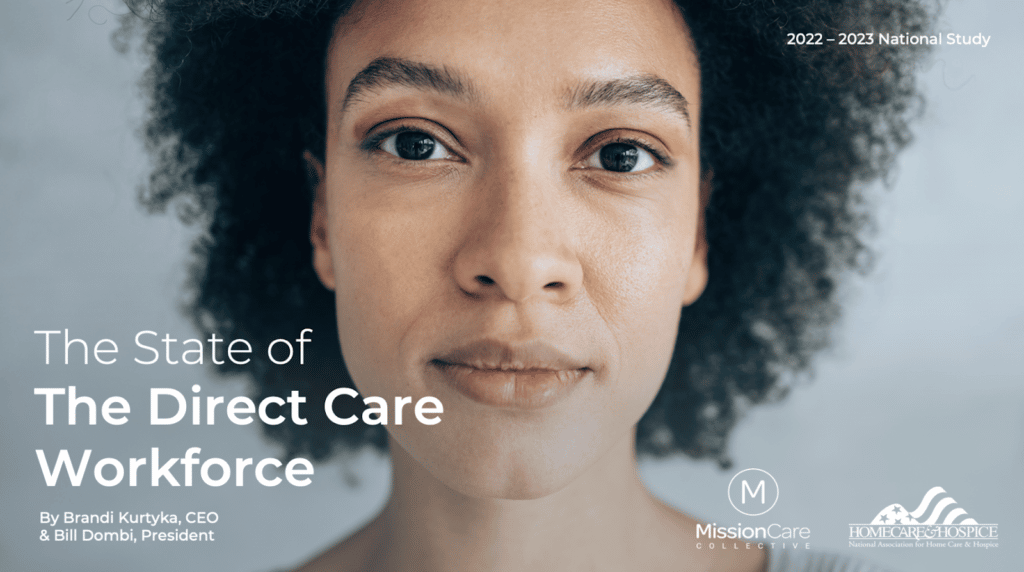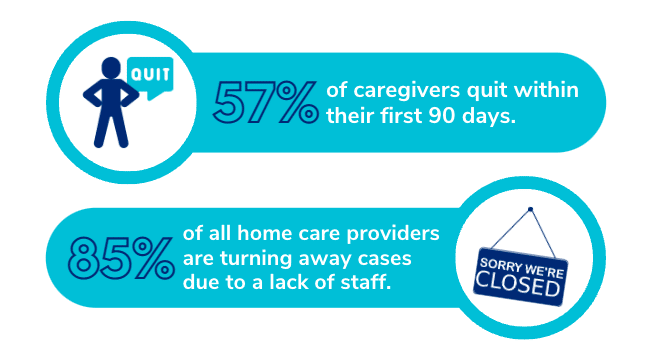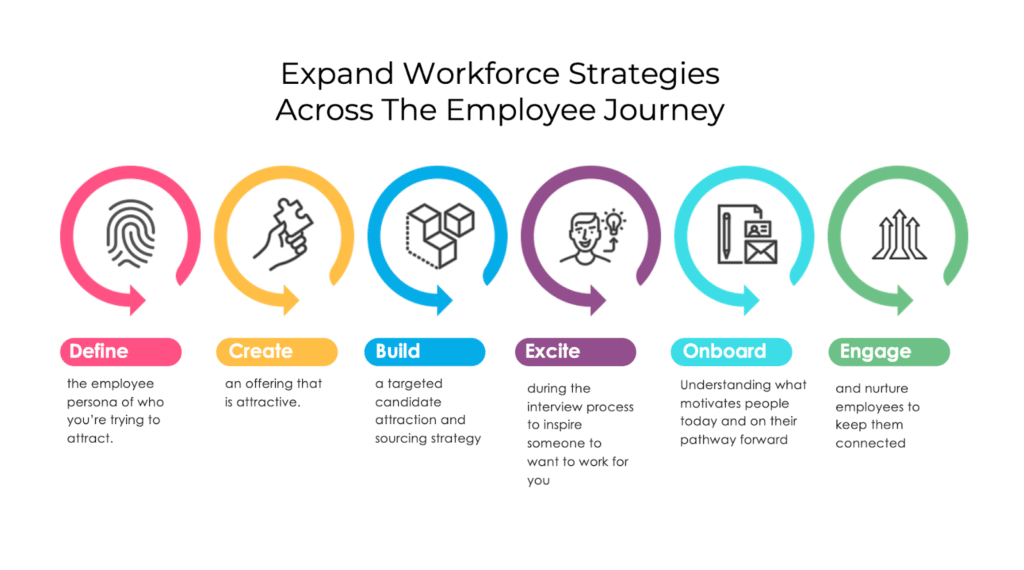Business owners in the direct care (or home care) industry know that while their work can be incredibly rewarding, it can also be difficult. One common struggle home care businesses face is frequent turnover and recruitment challenges.

In a recent webinar hosted by CareerPlug, direct care brand MissionCare Collective shared enlightening insights from their recent report on the care industry that can help home care owners and managers more successfully recruit and retain valuable members of their team.
We’re excited to share some of those insights with you. Be sure to download the full webinar led by the Vice President of MissionCare Collective, Maggie Keen.
The State of the Direct Care Workforce
This webinar on caregiver personas is based on the findings of a large study sponsored by MissionCare Collective that includes a sample size of 67,417 US based caregivers, certified nursing assistants (CNAs), and home health aids (HHAs) seeking work via MyCNAjobs between March and July 2022.

The State of the Direct Care Workforce Report was conducted to get a better understanding of the real people working in caregiving roles – who they are and what they need. As Maggie Keen shares, “The industry is plagued with a host of recruitment and retention challenges. This is affecting business’s bottom lines, but it also means that people are not getting the care they need.”
Learning more about the needs of caregivers can help employers not only develop better recruitment and retention strategies, it can also help change the culture of care for the better.

Key caregiver demographics
Women make up the majority of the direct care workforce. 90% of CNAs and 85% of caregivers and HHAs identify as female.
Though the direct care industry is rapidly growing, it still pays some of the lowest wages. Caregivers are 7x more likely to live in the poorest income category vs the average US population. They are 2.5x more likely to be renters vs homeowners. Additionally:
- 63% of CNAs and 59% of caregivers have a net worth of less than $24,999.
- 61% of CNAs and 59% of caregivers have $0 in discretionary income.
- 54% of homecare workers rely on some form of public assistance.
In addition to the general demographic information uncovered in this survey, the data presented a big opportunity. The study revealed that there isn’t just one type of caregiver – there are seven caregiver personas and learning about each of them can be a game-changer when it comes to recruitment and retention.
7 caregiver workforce personas and strategies across the employee journey
Marketing professionals often use “personas” to identify their target audience and how to market to them. This allows them to get really specific with their marketing and tailor it towards a specific group with unique needs.
In the same way, home care owners can identify caregiver personas to build a recruitment and retention strategy. Personas can help you understand who to target, how, and when.
Most providers are trying to recruit and engage everyone as if they are the same. Instead, realizing that there are several distinct personas and learning what’s important to them can help you expand your workforce strategy. Let’s go over the seven caregiver personas uncovered by the Direct Care Workforce Study and some tips for engaging them across the employee journey.

1. Career caregivers
The biggest defining quality for this persona is that they have worked as a caregiver for the last three to four years. Age varies in this group, but they have one thing in common: they want to build a career in care.
This persona cares deeply about gaining new skills in the industry and is more likely to want full-time hours as well as extra certifications. They also care about patient match and a stable schedule. This group wants to earn enough money in care to avoid working additional jobs.
When recruiting this group, you can often find them on niche job sites like MyCNAjobs.com and via referrals and local CNA programs. In your job description, highlight any growth opportunities and training you provide. During interviews, focus on the time you spend to match the right patients with the right caregiver.
The biggest turnover risk for this group is a bad client match; they are also concerned about losing hours. To keep this persona engaged, focus on transparency in scheduling and building trust. Let these caregivers know that you’ll work to maintain their schedule with their clients. In addition, offering paid time off and recognition can help with employee retention.
2. Caring-on-the-siders
In contrast to the career caregivers are the caring-on-the-siders. This persona typically has other work obligations and tends to work in hourly healthcare and side/clerical roles. This group is generally made up of middle-aged women that don’t have children.
This persona is transient, meaning they come in and out of the industry. They are often heavy internet users and can be recruited through major job boards and social media recruiting strategies. However, it’s important to make sure that your opportunity stands out and catches their eye. A great job description can help! Be sure to lead with benefits that you offer and since increased wages are attractive to this group, consider including compensation in the job posting.
Watch the video below from our Senior Director of People Natalie Morgan on crafting a job description that attracts job seekers:
You can also find this group working other jobs like retail and restaurants. Keen recommends carrying recruitment cards with you, so that you can always be ready to recruit from anywhere.
During interviews, focus on how you can help them build a schedule around their other obligations. Keep a tight pulse on their schedule preferences and know they may change over time.
Focus on individualized career paths that align with the life skills they are hoping to build – which may or may not be in care. Keen shares an example of a caregiver that is interested in working in human resources. In tandem to training them for their job, you may also help them with other goals by partially covering the cost of an HR class at a local college.
Keep this persona engaged by recognizing them for picking up extra shifts. Incentivize them with wages and public praise for their hard work.
3. Young and on-the-movers
This group is made up of young adults aged 18-24, and is typically a mix of students and working professionals that may or may not already be in the industry.
This group wants to grow and is looking for opportunities to do so. For this younger persona, flexibility is often more important than wage, and they embrace a “work to live” mentality instead of “living to work.”
This persona can be recruited via niche jobs boards, major job boards, and social media. University recruitment strategies can also be effective. Keep in mind that this persona may not be aware of the industry, so you’ll need to catch their eye and educate them on what a career in care looks like.
During interviews, focus on flexibility and scheduling, as well as the investment your company is making in their career development. This group appreciates the connection to their work, so sell your company’s values, vision, and mission.
Continued growth is critical whether big or small. Set short term milestones to keep this group engaged and be sure to focus on growth opportunities. Incentivize this persona with gifts cards and public praise for a job well done.
4. Oodles of offspring
This persona represents young households with children. Members of this group put family first and work second, and spend most of their money on their kids – this means that flexibility and wages are of the utmost importance.
This group is often made up of heavy internet users, so online job boards and social media are a great place to recruit. You can also find workers at churches and community events.
This active persona values people and relationships. When selling your opportunity, keep in mind that this persona is drawn to a supportive family-like atmosphere, and that their experience with their recruiter will make a big impact on their decision to work with you. In interviews, focus on your family-oriented culture and your desire to build a schedule that works with their life.
When it comes to retention, getting to know these employees well makes a huge difference. Make it a point to learn about their families and their story; invest in family-related events and social outings.
This group also cares about growth and upward mobility. To keep them engaged, create wage tiers for skills attainment and build micro-pathways within their career to help them grow.
5. Single moving mamas
This caregiver persona is the primary caregiver for their family and often has a below average discretionary income. Other defining characteristics are that they are more likely to be renters than homeowners and often frequent discount merchants.
This group is more likely to be recruited out in the community, though they may occasionally look at online job boards and social media for opportunities.
Wage progression and a flexible schedule are benefits that will stand out to them. Like the previous group, this persona will also place a big emphasis on their experience with their recruiter. During an interview, focus on family-oriented culture and flexibility.
This persona is highly motivated by coupons, discounts, and access to special programs. They value connecting with their employers, coworkers, brands, and causes they support.
Remember that this person is juggling a lot. Recognize them for doing it all and incentivize with public praise and creative benefits like coupons and special discounts.
6. Empty nesters
New retirees or those nearing retirement make up the empty nester persona. This group is typically content within this stage of life and enjoys spending time with their grandkids. They often have limited discretionary income, and see work as an enjoyable opportunity to connect with others.
This persona is more likely to watch daytime TV than to be a heavy internet user. So TV ads and recruiting out in the community can be really effective. Though they likely know what the care industry is, they may need a little education around what a job in care could look like for them. Let them know how a career in care can be a great way to spend their extra time, help them do good, and earn extra income.
This group is also drawn to a great client match and a consistent schedule. During interviews, walk them through your process of matching caregivers with the right person.
Once hired, keep a tight pulse on the caregiver and patient relationship. Recognize these employees for the impact they are making and incentivize with more formal awards and a clear bonus structure.
7. Still going strong retirees
This persona made up of females in their 60s is similar to the last group in that they enjoy spending time with their grandchildren and have limited discretionary income. They are interested in getting out of the house, earning extra money, and making an impact while doing it.
They likely know what the care industry is, but may not understand what a job in care could do for them. This is an educational opportunity for you – let them know how a career in care can be a great way to connect with people, help them do good, and earn extra income. Also highlight flexible scheduling that won’t interfere with their family time.
This persona worries about not having the skills they need to do a good job and turnover risk for this group is lack of training for a specific client. Drive home the importance of matching them with the right clients and ensuring they are trained to meet the needs of each client they serve.
Formal awards and bonuses can make this persona feel like they are doing a good job and keep them motivated.
Final thoughts
The thing that all these personas have in common is that they are all caregivers!
Think about these personas as they relate to your current workforce. Think about what matters to the groups represented on your current team and whether you are meeting those needs and engaging them in the right way.
Keep in mind that a healthy workforce is a diverse workforce. Consider the personas not represented on your team and how you can open doors for them to join the industry.
The seven caregiver personas laid out in this study can help you recruit new members of your team and keep your employees happy, motivated, and engaged. By developing a better understanding of the people that make up the direct care workforce, you can be more equipped to overcome recruitment and retention challenges and create a better culture in the care industry.




























